Adrian Collins's Blog, page 21
May 5, 2025
INTERVIEW: Joe Abercrombie
Joe Abercrombie is a celebrated British fantasy author known for his sharp wit and darkly humorous storytelling. He’s particularly skilled at bringing morally ambiguous characters to life—characters filled with cynicism, depth, and a touch of humor that makes them unforgettable. Often called one of the pioneers of grimdark fantasy, Abercrombie has captivated readers worldwide with his acclaimed First Law trilogy, which includes The Blade Itself, Before They Are Hanged, and The Last Argument of Kings, as well as compelling standalone novels like Best Served Cold and Red Country. With his work translated into many languages, Joe has undeniably made his mark as an influential voice in modern fantasy. It’s a genuine pleasure to chat with him today about his writing, storytelling, and his latest novel, The Devils.
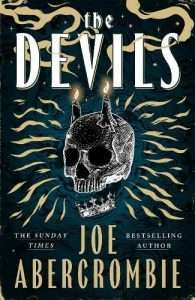 [GdM] Your characters often navigate the fine line between hero and villain. Do you see them as reflections of reality, where no one is purely good or evil? Or do you just enjoy making your readers question their moral compass?
[GdM] Your characters often navigate the fine line between hero and villain. Do you see them as reflections of reality, where no one is purely good or evil? Or do you just enjoy making your readers question their moral compass?
[JA] I guess a lot of the fantasy I read as a kid was very much in the shadow of Tolkien, and in Lord of the Rings there is an objective right and wrong. You either give in to Sauron or you fight him, and the text leaves no doubt which is good and which evil. Not that I ever lost interest in Gandalf and Aragorn but as the years went on I started to find Saruman and Boromir more interesting. People who fall from grace, or rise to it. Characters in flux, in turmoil, weighing greater good against personal good, with mixed motives, with uncertain outcomes. People who surprise the reader. In our world, everyone thinks they’re in the right. Battles aren’t of good against evil, but one man’s good against another’s.
[GdM] Your writing has been called cynical, but there always seems to be a single ray of reluctant hope shining on the ugly and dark. Do you think of yourself as a cynic at heart, or is that just a symptom of writing about war, politics, and human nature?
[JA] I don’t know that I’m a massive cynic at heart but certainly I’ve always been interested in the contrast between the kind of warfare, politics and human nature which we often witness in real life, and the heroic version on display in a lot of epic fantasy. I think a black and white view of the world is great for entertainment but it can be dangerous in reality. A little cynicism to sit alongside it is a healthy thing.
[GdM] Violence in your books is visceral, unromantic, and often has lasting consequences. What draws you to portraying it in such an unflinching way?
[JA] For me good writing is about putting the reader in the scene, experiencing it along with the characters. I think actual violence is visceral, unromantic, and has lasting consequences, for the victims and perpetrators both. Violent men, after all, are rarely the nicest people to know. As a reader the last thing I want is to feel entirely safe—that I know already who’ll come out on top and how.
[GdM] Have you ever written a scene that was so dark or brutal that you had to step away and take a break, leaving you unnerved that you came up with? Or do you relish putting your characters (and readers) through the wringer?
[JA] Scenes that come as a shock to a reader, that they might spend ten minutes with, the writer spends a lot of time thinking about. You plan it, you draft it over the course of days, you come back to it and rewrite it, reshape it, edit it, over and over, in an effort to create exactly the effect you want and make the maximum impact. I think the aim of a book is to get a strong response out of the reader, and the characters are really tools with which to do that. So there’s not much point pulling your punches.
[GdM] Can you tell us about your upcoming book, The Devils?
[JA] It’s one of those books about a group of monsters, including an oversexed werewolf, an overconfident magician, a geriatric vampire, an invisible elf, and a knight cursed with immortality, led by a monk who never even wanted to be a monk on a fool’s errand to install a thief on the throne of Troy on behalf of the Pope who’s a ten year old girl.
[GdM] After spending years in The First Law universe, what challenges and freedoms did you encounter while crafting a new world in The Devils?
[JA] It’s great to have all that well-established background, old characters and events to draw on writing a First Law book, but it’s also a lot of load to carry, a lot of things to get right, a lot of text to check. And a lot of expectation from readers who want a continuation of this plotline or that, a payoff of one kind or another. There’s definitely freedom in starting something entirely new, especially something that’s meant to be episodic and not especially coherent. I hardly dare say the word fun, but that was what I was after.
[GdM] You mentioned calling the world of The Devils an “alternate history is being too dignified about it.” It is the “stupid version of our world.” How fun was that to write? Did you seek out specific historical events to subvert, or was it throw whatever ideas came to you and see what stuck to the proverbial wall?
 Author Joe Abercrombie
Author Joe Abercrombie[JA] New books are always fun for a while—the glory of new possibilities, the experimenting with new characters, but I find about a quarter of the way through they start to become work again. Then it’s the long grind through a draft, often while cursing god and wishing for ragnarok and pronouncing your career over to anyone who’ll listen, and it’s only towards the end that you start to get the enjoyment back. Then the editing and revising, seeing it all come together is where the fun is. I’ve always been a more character than world-focused writer, and the idea with the Devils was really to make the world as vague and ill considered as possible. This is the opposite of punctilious world-building with lists of dates and carefully drawn maps. I want the world to feel like a vague fever dream against which the characters and events explode with double the impact…
[GdM] You’ve mentioned a conscious effort to include more female perspectives in your work. How did this intention manifest in The Devils, and how does it impact the story?
[JA] The First Law trilogy was very male focused, for sure. I’m proud of the female characters in it but there aren’t many of ’em. There’s nothing wrong with writing about men, and as a man it’s the automatic option, but in general I don’t see much downside to more variety in the cast—different attitudes, different struggles, different types of relationships. It just helps a world feel more vivid, and lived-in, and well, real. The real world’s got lots of women in it, after all. As did the medieval world. Often doing strange, unexpected, interesting things. What happens if you put a woman in the kind of role where you might expect, default, a man? So in the case of The Devils I made the Saviour figure a woman. Female Saviour, therefore female priesthood, female Machiavellian cardinals, ten year old girl for a Pope. The central cast is pretty evenly split and because they’re, you know, actual monsters, you get all types. There are some classically feminine women, like courtier par excellence Lady Severa, but also in some ways some very masculine ones, like explosively violent and aggressively sexual werewolf Vigga. There are some very masculine men, like grizzled warrior Jakob of Thorn, as well as some quite feminine ones, like cloistered monk Brother Diaz. For me it just makes for a richer and more varied tapestry.
[GdM] The Devils is noted for its dark humor, as is most of your work. How did you balance comedic elements and the grim aspects of the narrative?
[JA] I don’t know that it needs much balancing. My approach has always been that there’s never a bad time to be funny, and there’s never a bad time to be horrifying. Often the two work best right up against each other, in the very same scene. Like light and shadow in a painting, they only intensify each other. As you edit and revise you obviously refine things to give a scene the tone you want, but often that’s just about judgement and timing and cutting stuff down to make it as impactful as possible. Very rarely would I think—hmmm, I need to make this scene less funny. Who wants that?
[GdM] The Devils feature characters reminiscent of classic horror figures like vampires, werewolves, and elves. What drew you to integrate these archetypes into your story, and how did you approach making them unique to your world?
[JA] People often celebrate originality as some kind of absolute good but I’ve always felt a little of it goes a very long way. I’ve always loved stories like Unforgiven, which takes a new look at some very classic, beloved genre, and serves as both a great example of the form and a comment on the form at the same time. That was really the approach to fantasy I took with The First Law. So with the Devils, which obviously has some horror elements to it, centred on a group of monsters, I wanted to include the classics. Suave vampire, uncontrollable werewolf, sneering magician. These things become archetypes because they work. It’s all in the application, really.
[GdM] Which of the main characters—Vigga, Sunny, Barron, Rikard, Balthazar, Jacob, or Baptiste—did you have the most fun writing? Which was the most challenging?
[JA] Well they all offer different challenges and serve different purposes. It’s like the ingredients in a cake—the project doesn’t work without all the elements. But I generally find characters with a very strong but quite one-noted personality, who often don’t carry a lot of the plot on their shoulders, are easy to write, while those who are more at the heart of things and therefore steer the plot and perhaps change over time themselves are more of a challenge. So Vigga was a lot of fun to write, for sure. But then she works because of the contrasts with and the interactions with the others. You need some more ‘normal’ people for her to knock against. And kill.
[GdM] If you, our liege and Lord Grimdark, could bestow an honorary title of Duke/Duchess of Grimdark to another writer, whom would it be and why?
[JA] Oh, titles such as that can never be bestowed, only won for oneself, preferably standing atop a mountain of skulls.
[GdM] Who would you choose if you could collaborate with any author, living or dead? What kind of book would you write together?
[JA] I work quite a lot in the film and tv world these days, and those projects are by nature a collaboration with a whole ensemble of different talented people of one kind or another. There’s a lot of reward in that way of working. Lots to learn, lots of ideas to absorb, and it’s sometimes great to be part of something bigger. But I think that work satisfies my need for collaboration, and there are frustrations too. It’s sometimes great to have the final say, and not have to make compromises. So though I love working with editors, fiction writing for me is really quite a personal thing—can’t imagine doing it with someone else. Although obviously a dead writer wouldn’t offer much criticism…
This interview was first published in Grimdark Magazine Issue #42
Read The Devils by Joe Abercrombie
The post INTERVIEW: Joe Abercrombie appeared first on Grimdark Magazine.
May 4, 2025
REVIEW: Attack on Titan Season 1
Vicious. Bleak. Blood and loss. Characters carving their way out of hopeless situation through swords and sacrifice. Attack on Titan is not only a grimdark masterpiece, it’s the finest written T.V. show I’ve ever seen.
 “It Doesn’t Matter How Strong The Opposition Is. It Doesn’t Matter How Fearsome The World Is, It Doesn’t Matter How Cruel The World Is. Fight!”
“It Doesn’t Matter How Strong The Opposition Is. It Doesn’t Matter How Fearsome The World Is, It Doesn’t Matter How Cruel The World Is. Fight!”
Season one of Attack on Titan sets the pace, establishes the world, and foreshadows future events with a fine touch. We’re introduced to a medieveal-ish world where citizens live in cities behind looming walls in fear. Outside those walls live “titans”, fleshy, naked, humanoid giants. These titans range, on average, from 20-40 feet tall and operate on one instinct and one instinct alone: eat humans.
While the titans are a threat and the people are trapped in cities, life is relatively peaceful, for the first fifteen minutes of Attack on Titan, at least. The walls keep the citizens safe, and on the rare occurrence that a titan needs to be dealt with, humanity has developed an invention called “ODM gear” or “Omni-Directional Mobility Gear,” a device that allows soldiers to swing around in a spiderman-esque fashion, and the city has soldiers available to deal with them.
Until an intelligent, armored titan and a colossal titan break open the gate to the city.
Titans flood the city, eating as many humans as they can get their hands on. Our main character, Eren Yaegar, watches his house collapse on his mother, leaving her paralyzed and defenseless. Titans descend on her. With a smile, one eats Eren’s mother, spraying blood and viscera as Eren watches helplessly.
And that’s only episode one of Attack on Titan.
Fueled by hate for titans and a desire to reclaim the outside world, Eren, his friends Mikasa & Armin, and a collection of other recruits join a military training program. They train in ODM gear, nape slicing (the only way to kill a titan–slicing the back of its neck), and martial training. When they graduate the academy, they’re allowed three options: join the military police, an elite force that protects the highest ranking citizens and sees little active duty, the Garrison, a force that watches the walls and lives in the city, or the Scouts, a force that goes into the wild and into Titan captured lands, looking to bring humanity forward.
Eren and his friends have a decision to make, but little do they know that Eren has a power. A secret that he doesn’t know he’s keeping. When things look the most dire, it’s revealed, but it leads to more questions than answers. Especially when a traitor with a similar power is discovered…
A game of cat and mouse develops. People play chess with human lives. Intelligent characters duke it out with gambits, plans, and deception. I’m a slut for smart characters actually being smart, and Attack on Titan has that in spades.
We’re born free. All of us. Free. Some don’t believe it, some try to take it away.
The premise of Attack on Titan is strong. You can feel the amount of planning that Hajime Isayama, the author of the manga, spent on crafting it. Everything, from large concerns to small, is thought out.
And ultimately, that level of world-building pales in comparison to the amount of plot building and foreshadowing established in Attack on Titan. The show will put blatant hints of twists in front of your face, say “you’re too dumb to know what this means, but it will make sense”, and then be proven right. From a plotting and planning perspective, the only piece of media that rivals that level of care and foresight would be Malazan. Attack on Titan is that intense.
The animation is fucking incredible. The ODM gear, comprised of iron wires and grappling hooks attached to the hip, creates some of the coolest scenes in anime. Shot after shot of action and loss is depicted both beautifully and brutally. Some scenes will make you cringe with its brutality, some will make you cheer at seeing the characters finally carve out a victory.
Listen, it’s a perfect show. I used to hate anime, outside of the original Naruto series I caught on Cartoon Network as a kid, and then I saw this. I’m now a full on weeb who is ready to kill for Jujutsu Kaisen season 3 and Chainsaw Man season 2. I’m embarrassed to admit that, and it’s all Attack on Titan’s fault.
If you want the finest written T.V. show of all time, brutality and sick world-building, mysteries and twists, intelligent characters, or just some fucking cool action, close this review and go pick up Attack on Titan.
The post REVIEW: Attack on Titan Season 1 appeared first on Grimdark Magazine.
May 3, 2025
REVIEW: Cold Silver for Souls by Tori Tecken
You know, I honestly just about died from excitement when Tori Tecken announced Cold Silver for Souls. Just hear me out, a necromancer bounty hunter fantasy western with a lone wolf and cub dynamic and the best found family vibes, all set in a world inspired by the wild west and the Yukon Gold Rush? Say no more. It’s dark, it’s gritty, it’s so darn cool, but most of all, it’s a soul-stirring tale of growth, change, connection, healing and the unimaginable resilience of the human spirit. 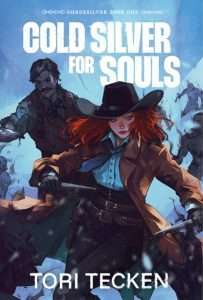 “It’s not as bad as Paradise, but even here, I’m still the necromancer. The corpse raiser. The northerner. It’s like they’re never quite sure if I am human or not.”
“It’s not as bad as Paradise, but even here, I’m still the necromancer. The corpse raiser. The northerner. It’s like they’re never quite sure if I am human or not.”
From the moment I met my girl Hunter, I was completely in love. Okay, in love and maybe also slightly intimidated, because she more than lives up to her fearsome name and she’s honestly so much cooler than I ever could be. I mean, she’s a fierce redhead born and bred in the merciless northern winters who spends her days collecting bounties by hunting down thieves and murderers together with her animated corpse, Rip. In a way, she could so easily have fallen into the ‘not like other girls’ strong female character archetype, and yet she totally doesn’t. She’s a complicated woman who contains multitudes, and I absolutely loved peeling back a few of her layers as her latest mission goes a bit off the rails and turns her entire world upside down.
“It’s never too late to start a new life. You’ll never run so far that you can’t come back.”
Now, in her previous works The Blood Stones and Phased, Tecken already showcased and proved her exceptional skill at writing complex characters with real human emotions and the most complicated interpersonal relationships, but I feel like she took that to the next level in Cold Silver for Souls. See, much as Hunter likes to pretend she is a cold-hearted outcast with a lot of swagger who totally thrives on wandering the cold plains all by her lonesome, she is honestly a really tender soul with a heart of gold (or should I say silver?) who will do anything to protect the ones who have earned her love, loyalty and affection. I mean, I am always a sucker for some good unexpected found family vibes, and this book delivers on that in spades.
Especially the lone wolf and cub dynamic between Hunter and Johnny, a young boy with budding necromancer powers who she somewhat reluctantly takes under her wing, gave this dark and gritty story so much heart, and the tentative blossoming of their relationship tugged on my heartstrings in all the most unexpected ways. But then we also have Addy with her irresistible Charm (what a hoot!), the kind Reverend Ambrose, the badass Jo Farstep, and of course the gentle queen of the kitchen, Kay (this book made me way more hungry than it had any right to!). While most of them are not (yet) as three-dimensional as Hunter, they each pop off the page with personality (even the horses, much to Hunter’s dismay) and add so much heart to the story.
“If there’s something people fear more than death, it’s being forgotten. Of being insignificant like the dirt somewhere underneath the snow. But I figure sticks tied to a cross aren’t much of a remembering. If there aren’t people living and breathing who remember you fondly, well then, I guess you might not be worth remembering much.”
Moreover, I loved how their unwavering support and little gestures of kindness towards Hunter shone all the brighter in contrast to the cold cruelties that she has to endure in this unforgiving world day in and day out. The way that Tecken interweaves the internal and external conflicts and explores themes of trauma, loss, othering, morality, humanity, faith, exploitation, the fear of the unknown, and the dangerously thin line between justice and vengeance is extremely powerful to me, and I think that is exactly what makes Cold Silver for Souls such a gripping and unforgettable tale despite its shorter page count.
“It’s the easiest thing in the world for a person to let go of something that wasn’t done to them. They’ll tell you what would be best, and how you can live for more. But it’s not their wound that’s bleeding out.”
Yes, we hit the ground running and just keep moving along at a steady pace as both old and new threats emerge around every corner, but I never felt like the development of the world or the characters suffered for it. Hunter’s intimate and increasingly vulnerable first person (present tense) narration was just so immersive to me, and I soon felt like I was transported straight into the wild Territories myself; I felt the biting cold of the North, I was overwhelmed by the awe-inspiring beauty and power of mother nature, and I just revelled in all the intense emotional turmoil that these characters experienced as their past came back to haunt them.
“You don’t mess around with things up here. If it’s not the cold that gets you, its teeth and claws. And if it ain’t either of those two things… it’s the Shades. When you’ve met a Shade face to face, getting eaten by a mountain bear doesn’t sound all that bad.”
Similarly to in Sarah Chorn’s Of Honey and Wildfires, this fantasy western world feels both terrifyingly realistic and excitingly strange and miraculous, and I loved how Tecken evoked the wild west vibes of the Gold Rush Era but put her own fantastical spin on it all. To me, Tecken does a masterful job of scattering in just enough little nuggets of history (be that personal history or world history) to breathe so much life into the world and the characters, while also keeping certain details shrouded in mystery for now to maintain an addictive level of tension and intrigue that had me ripping through the pages. What is up with the Shades and Shadesilver? What exactly happened to Hunter’s Pops? How did Rip end up being tethered to her and why does she harbour so much resentment towards him? Is Rip gaining sentience and autonomy? I am dying of curiosity and would honestly sell my soul for the next instalment now!
“Sometimes I wonder how much he does feel, connected to me the way he is through that tiny splinter of soul. He might get a little of whatever I experience, tiny wisps of emotions through the magic linking us. If that’s all he gets, held in the Between, then that’s fine by me. He was damned long before I found him.”
With the Shadesilver series being inspired by the episodic storytelling style of the 60s and 70s, it really feels like we have only barely scratched the surface here and I am so ready to mine even deeper to uncover all the treasures that this world and these characters have to offer. Cold Silver for Souls is honestly everything I didn’t know I needed in my life, and I can’t recommend it highly enough if you like the sound of a necromancer bounty hunter adventure with a fantasy western twist, a deadly high cool-factor, and equal parts action, grit, emotion and heart.
Thank you to the author for providing me with an eARC in exchange for an honest review. All opinions are my own. Cold Silver for Souls is scheduled for release on May 27th.
The post REVIEW: Cold Silver for Souls by Tori Tecken appeared first on Grimdark Magazine.
May 2, 2025
REVIEW: Tyrant’s Throne by Sebastien de Castell
Tyrant’s Throne—Sebastien de Castell’s finale in the Greatcoats Quartet—is a bittersweet ending that lands the plane and serves as a triumphant capstone of an incredible series. Witty, epic, rapidly paced, dark, and with the highest stakes that de Castell has given, Tyrant’s Trone sees Falcio off with an ending that delights.
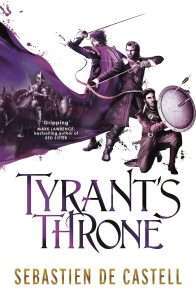 “Any man who uses the words ‘politics’ and ‘trust’ in the same sentence has disqualified himself from talking about either.”
“Any man who uses the words ‘politics’ and ‘trust’ in the same sentence has disqualified himself from talking about either.”
No one in the world makes me smile quite like Sebastien de Castell. His pacing is set so that you fly through the pages, his banter is laugh out loud funny, and his characters—despite facing immense odds in a dark world—have so much heart and grit that you can’t help but root for them.Tyrant’s Throne feels like all of those skills have been sharpened to a knife point and paint de Castell at the height of his powers.
Before digging into the contents of Tyrant’s Throne, I wanted to give a special shout out to the antagonist of the book. He’s so fresh and feels alive. I was looking over my shoulder as I wrote this review, expecting him to be in my shadow. While de Castell has always had exceptionally good character work, the antagonist of this one may be his best, most nuanced character to date.
Now, the journey of Tyrant’s Throne is classic de Castell. Twists, intelligent characters, two-to-three page chapters, and an avalanche of fun. There’s also some themes of depression and self hate, which, if you know Falcio, is also classic de Castell. The Greatcoats has gotten better with each book, and Tyrant’s Throne is a well done finale. If you’re reading this review because you found the first three decent-to-good, I highly recommend finishing the series.
Every de Castell book I’ve picked up ended up being read in under 48 hours, and Tyrant’s Throne was no different. He’s an absolute master at lacing humor into his dialogue and prose, as well as pacing the book to keeping readers invested. A personal inspiration to me as an author, he once again displays mastery of the quill, wit, and imagination.
“If they like stories about seven fearless warriors facing a thousand enemies, maybe they’ll appreciate one suicidal idiot running at them while screaming like a maniac.”
With the good parts handled, I did have one nagging issue: the climax. Of all four books, Tyrant’s Throne does have the weakest climax, which is a shame, considering it’s the finale. A lot of the cloying issues that you’d see in something like Dragon Age: Inquisition are on display for the last bit. The epilogue is rather nice and serves excellently as a good-bye to Falcio and his friends, but still, the after-taste of the climax is present.
Overall, Tyrant’s Throne sticks the landing to standing applause. Sebastien de Castell confirmed that The Greatcoats is always going to be one of the best, and most fun, fantasy series published this century.
Read Tyrant’s Throne by Sebastien de Castell
The post REVIEW: Tyrant’s Throne by Sebastien de Castell appeared first on Grimdark Magazine.
May 1, 2025
REVIEW: The Sins of Steel and Shadow by Steve Pannett
Two years ago Steve Pannett impressed with his self-published debut The Hunter’s Lament, a grim fantasy with a tense and addictive plot, full of brilliant close-quarters action and subtle character work. Now Pannett has sought to build on that formula but, Spinal Tap-style, cranked the ambition up to eleven by presenting the first in a new (grim?)dark series The Turned, full of assassination, politics, vampires, humans, and things in between. The Sins of Steel and Shadow is a cracking first instalment that shows his ambition was not misplaced.
 The plot concerns the Turned: half-human, half vampires, hated by everyone. Bail, a Turned, survives by selling human military secrets to the vampires in return for valuable relics. But when an emissary of the human king summons him and several other Turned for a mission—assassinate four key figures of a plot to overthrow the King—in return for the cure to his condition, he sees the opportunity to be human and no longer loathed.
The plot concerns the Turned: half-human, half vampires, hated by everyone. Bail, a Turned, survives by selling human military secrets to the vampires in return for valuable relics. But when an emissary of the human king summons him and several other Turned for a mission—assassinate four key figures of a plot to overthrow the King—in return for the cure to his condition, he sees the opportunity to be human and no longer loathed.
There’s a lot to love in The Sins of Steel and Shadow. The worldbuilding—a vampire kingdom balancing a fragile peace with the neighbouring human kingdom—intrigues, although a lot is clearly being held back for the sequels, and the plot is addictively readable. There’s few things more fun than a bunch of assassins and a kill list, and Pannett uses this to his advantage, introducing a series of grim and conniving characters, all anchored on the central character of Bail, who’s a fascinating character to read not just because of his inner turmoil about being a Turned and his smart skillsets, but because he’s a refreshingly thoughtful character, which is helpful given his team include a permanently furious dagger-wielding woman with a tragic backstory and a tendency for literally burning everything down. There’s a bit of a slow start as the plot is established, but once the kill mission begins, it’s non stop, grim entertainment.
Then there’s the fight scenes. These are violent, engrossing action set pieces full of vicious injuries and kinetic, simple, yet effectively choreographed encounters. These violent blitzes that frame the finales of each assassination mission won’t just make you wince at the wanton bodily destruction (fans of daggers in faces, your time is now) but will suck you in with the careful, blow-by-blow narration. There is a true art to this kind of fight-write, and Pannett has it. One particular nasty set piece involving some forest traps laid down for some unsuspecting hunters galloping past is utter carnage in a can’t-look-away variety and one of the most brutally memorable scenes you’ll read in a fantasy this year.
But although the action is a headline reason to read, Pannett has more to his bow than that. There’s some meaty themes about discrimination and self-hatred in The Sins of Steel and Shadow. What makes a person and what makes a monster? Is it really important if the Turned get “cured” and get their humanity back? Or is it more important how you act, whether your ears are pointy or rounded? Pannett isn’t one to hammer themes over your head, but he does like his characters to chew over them. Just as impressive is his character development. Although there’s still a lot to come from these characters and it does feel like they’re just getting warmed up in the series, there is some subtle emotion and character development here, one of Pannett’s strengths. Oh and some great twists, as you’d expect from a tale like this full of connivers and spies.
Sins of Steel and Shadow is a great start to a promising new fantasy epic: an action-packed, bloody, character-driven fantasy ride in a fascinating, gritty world. The real sin is leaving this on the shelf.
Read The Sins of Steel and Shadow by Steve Pannett
The post REVIEW: The Sins of Steel and Shadow by Steve Pannett appeared first on Grimdark Magazine.
REVIEW: Atacama by Jendia Gammon
Last Updated on May 1, 2025
Expanding upon an idea first introduced in her short story collection, The Shadow Galaxy, Jendia Gammon’s cosmic horror thriller, Atacama, takes readers on a chilling journey that begins with a seemingly innocuous sample taken from the Atacama Desert by a university research team.
 The specimen’s nature quickly becomes the central mystery, as a professor and a student’s initial encounter with it yields dire consequences. Atacama’s opening chapter introduces the novel’s most fascinating element: its ability to create a genuinely unsettling experience.
The specimen’s nature quickly becomes the central mystery, as a professor and a student’s initial encounter with it yields dire consequences. Atacama’s opening chapter introduces the novel’s most fascinating element: its ability to create a genuinely unsettling experience.
It’s always exciting to see an author extending a preamble, especially one cloaked in impending doom.
The uncanny atmosphere of Atacama’s opening chapters permeates both the novel’s cosmic horror elements and its protagonist, Fiona Hawthorne, a research student grappling with her best friend’s recent death and the gradual dissolution of her engagement.
Seeking to find the truth behind this sudden death, Fiona begins her journey as isolated as the desert the novel is named after, but with help from a long-absent university friend, she evolves alongside her grief. Her personal experience complements the otherworldliness of the alien elements, touching on that intersection of self, intimacy, and the preternatural that is so intrinsic to the horror genre.
Gammon excels at portraying the encounters with the alien entity with creativity and an authentic sense of wrongness. Its peculiar characteristics also added an eerie dimension to the narrative that kept me on edge.
Sudden and forced interactions with the alien and the horrific repercussions of its behavior highlight its profound otherness, making each confrontation deliciously creepy, but my appetite for these moments wasn’t fully satisfied.
Atacama focuses on character development, crafting a personal story about coping with sudden grief and moving forward—albeit with a terrifying alien complication. The protagonist’s emotional journey forms the narrative’s backbone, giving weight to the supernatural elements before eventually overshadowing them until they feel secondary.
As the novel progresses, the narrative imbalance between the more mundane, personal scenes versus the alien encounters creates an uneven reading experience. Additionally, the romantic subplot unfolds too quickly—Fiona’s abrupt transition from a broken engagement to a new relationship with said friend she recently reconnected with feels rushed and undermines the emotional authenticity established by the other elements of the story. Although this plot point does get addressed in the endgame, and its existence does make a case for the difficulty we have putting our first foot forwards by ourselves when dealing with our grief, it does stand in the spotlight for enough time to slow down everything else around it.
Moreover, despite the title’s implication, the Atacama Desert only appears in the final stages, with Fiona spending minimal time in this expectedly central location, one whose predominance I hoped would add to the uncanniness of the story and play with more than one kind of horror of isolation.
Despite this, I thoroughly enjoyed the alien aspects of this novel, smartly crafted, making Atacama a compelling read for fans of sci-fi horror.
Although I wished for better pacing and deeper romantic development, Atacama delivers an unsettling exploration of grief through a distinctly extra-terrestrial lens, and Gammon’s talent for crafting alien entities and exploring their interaction with human vulnerability makes the novel an entertaining addition to the cosmic horror genre.
Read Atacama by Jendia GammonThe post REVIEW: Atacama by Jendia Gammon appeared first on Grimdark Magazine.
April 28, 2025
INTERVIEW: C.M. Caplan
C.M. Caplan is the author of the Four of Mercies, a series featuring cyborg horses, autistic quadruplets, and all sorts of Weird Shit . The Fall Is All There Is, book one of the series, was an SPFBO9 finalist and the sequel, The Diplomacy of the Knife, was released on February 20th, 2025. When not writing, C.M. is usually rambling on Bluesky, chugging Dr. Pepper by the gallon, and talking to other unique souls. Grimdark Magazine‘s very own Z.B. Steel was fortunate to get the chance to catch up with him and talk about his writing, his reading, and what is on the horizon for C.M. Caplan.
. The Fall Is All There Is, book one of the series, was an SPFBO9 finalist and the sequel, The Diplomacy of the Knife, was released on February 20th, 2025. When not writing, C.M. is usually rambling on Bluesky, chugging Dr. Pepper by the gallon, and talking to other unique souls. Grimdark Magazine‘s very own Z.B. Steel was fortunate to get the chance to catch up with him and talk about his writing, his reading, and what is on the horizon for C.M. Caplan.
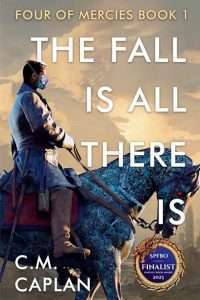 [GdM] Hey Connor, thanks so much for doing this interview! To get things started, want to pitch Four of Mercies to the lovely people reading this?
[GdM] Hey Connor, thanks so much for doing this interview! To get things started, want to pitch Four of Mercies to the lovely people reading this?
[CMC] Thank you for inviting me to do this interview!
Okay, so Four of Mercies is science fantasy trilogy about a set of quadruplet royals undergoing a succession crisis, told from the point of view of the youngest. It’s a really tight, almost claustrophobically first-person narrative that involves cyborg horses, motorcycles with an engine made of nerve endings and spinal fluid, ghosts that you can breathe in and get infected by, castles are made from prehistoric skeletons, and ships with engines powered by gigantic human hearts that sometimes require surgery.
It’s batshit insane, is what I’m saying.
[GdM] The title’s for Four of Mercies so far have come from The Lion in Winter and the works of Robin Hobb. This begs two questions: Who is on Connor’s “favorite fantasy author” Mt. Rushmore & do you have working titles for any future works?
[CMC] Oh god, this is like asking a parent who their favorite child is. I feel like this answer changes yearly, if not every six months or so, in relation to where I’m at in life and what I feel I need from SFF. I think right now I’d probably go with Robin Hobb, NK Jemisin, Tamsyn Muir, and…I’ve been really vibing with M John Harrison, at the moment. But if you asked me even a couple months from now you would probably get a completely different set of answers.
As far as future titles are concerned—the working title for book three is The Blood is Compulsory, but that feels a bit too pretentious so I’m not sure if it’ll stick. It’s from Rosencrantz and Guildenstern Are Dead.
“I can do you blood and love without the rhetoric, and I can do you blood and rhetoric without the love, and I can do you all three concurrent or consecutive, but I can’t do you love and rhetoric without the blood. Blood is compulsory—they’re all blood, you see.”
[GdM] You were a finalist in SPFBO 9, a huge accomplishment. How’s life been since then?
[CMC] Oh it’s been phenomenal! I just put out book two, The Diplomacy of the Knife, about two months ago! I’ve been getting some really angry DMs about it, which has been lovely. And I’m trying to figure out if I can finish book three in hopefully a bit less time than it took me to write book one. Though at the rate I’m currently going I dunno how that’ll pan out.
[GdM] Speaking of SPFBO, are you pulling for any of the finalists for SPFBO X?
[CMC] Oh god you can’t make me choose! I know how stressful it is to be in any spot on that scoreboard! I just hope they’re all having a great time with it! It’s such a great honor to get picked for SPFBO so really I just hope everyone’s buckling in and enjoying the ride.
[GdM] I’m going to give you some rapid fire topics, give me the first thing that comes to mind when you hear them:
CyborgThe guy on the Teen Titans animated show. Specifically the 2003 version.
WeirdA short comic from Weird Fiction (I think??) published by Timely Comics in the 40s (I think??) where two scientists invent time travel to see if the past can be changed, send a capsule back to the Jurassic Era, then it cuts back to them and they’re both dinosaurs and they’re going “It worked! See? The past can’t be changed!”
Alright, that wasn’t very rapid fire. I’ll speed up with the rest.
GOATJohn Darnielle.
NarniaPeter Pevensie’s sword, Rhindon
SwordSorcery
SpiderA Guest for Mr. Spider, a terrifying little book from The Magnus Archives
Grimdark MagazineINCREDIBLE!!
PepperTrue love.
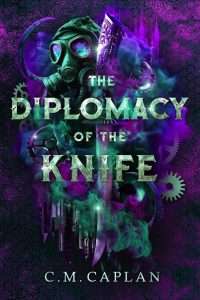 [GdM] Petre makes a lot of dumbass decisions–do you ever feel sympathy for him or do you like seeing him (and your audience) suffer?
[GdM] Petre makes a lot of dumbass decisions–do you ever feel sympathy for him or do you like seeing him (and your audience) suffer?
[CMC] Oh I love him so much. I feel tremendous sympathy for him because he’s the product of a family and a system that has let him down at every turn. He’s been convinced that the only way to solve problems is through having more power than other people, and being more violent. And you can see these glimpses where he’s actually much smarter than even he thinks he is. But then he goes and does a bunch of stupid shit anyway because it’s been drilled into him that he has to be a certain type of way in the world.
But at the same time, there’s a part of me that really relishes the wince you feel before he makes a lot of his decisions. If I’ve done my job right, you both see how he’s fucking up, and why he’s going with such a disastrous option. And on that level I do like the suffering, if only because I’ve put so much work into crafting this exquisite torture, and the agony afterwards is the sign of a job well done.
[GdM] What are you currently reading?
[CMC] I just finished Lord of Scoundrels, a delightful romance novel Quenby Olson recommended to me to familiarize me with the genre so we can eventually co-write something (if our schedules ever clear up enough to get to it.)
[GdM] In your interview with Rune S Nielsen you said that you hated the ending of a comic book so much that you became a writer out of spite. Any chance you can reveal the name of the comic?
[CMC] It was the ending of Secret Invasion. And don’t get me wrong—Bendis is one of the best writers in the business. He’s got top tier dialogue. His style is incredibly decompressed. I really love his work with street level heroes in particular. He’s did some incredible stuff for Luke Cage and Jessica Jones especially in the 2000’s. But I think Norman Osborn assassinating Veranke, the Skrull Queen was just—it wasn’t a bad decision. It made for a phenomenal run of books themed around Osborn as director of SHIELD. But I think it was a mixture of both event fatigue, and just…a feeling that the narrative momentum wasn’t fully there to earn the initial twist. You’ve got Nick Fury coming out of hiding, all these heroes who had been at odds during the era after the Superhero Registration Act, and it looked like it everything was going in the direction of tying that all up. And then suddenly one dude blows Veranke’s head off on TV and all that narrative momentum fizzled out.
But again, Bendis is an incredible storyteller and I dunno who came up with what decision, and the arc that came out if that twist was truly incredible. I don’t know how I’d feel if I went back and reread it as an adult. But as a kid it annoyed me enough to get me writing my own stuff. And I can promise you that early stuff was absolutely not better than Secret Invasion.

Author C.M. Caplan
[GdM] What’s your favorite Arthurian legend?
[CMC] I’m trying to remember if I’ve divulged the fact that Petre’s earliest roots as a character started in a YA book I wrote about the suburban ancestors of the Knights of the Round Table…
Anyway, it’s gotta be Sir Gawain and the Green Knight. It’s got everything. Weird court rules, beheadings, phenomenal character arcs, homoerotic undertones. I mean the Grail Cycle is cool too if you want something big and epic depressing. That’s not meant sarcastically, it’s genuinely really good. Like it’s genuinely my second choice pick. But Green Knight is this really tight narrative with a clear character arc that wraps up real well. I really dig it a lot.
[GdM] Between Ghostfog, Cyborg horses, the swords, and Petre himself, you got a lot of weird, dope shit going on in Four of Mercies. Were there any ideas that you scrapped because they were TOO weird?
[CMC] I very nearly scrapped the cyborg pugs because they seemed a little frivolous, but Sara from Fiction Fans, who I was living with at the time, made me keep them so I could name a pug after one of hers.
There were some ideas I scrapped for not being weird enough. The first version of book one had chainsaw swords instead of science swords. And I changed it because like—sure, that’s cool. But it’s been done, y’know? If it wasn’t weird enough to make someone go “is this guy okay?” I had to keep refining the concept.
[GdM] Thank you so much for doing this interview! Anything you wanna say to the people still reading? Maybe threaten them with yelling, bribe them with make-up pictures, or finally admit you don’t actually drink Dr. Pepper?
[CMC] How dare you, sir. I drink so much Dr. Pepper I’m pretty sure my blood is carbonated.
Go buy my book and/or I’ll bring back thirst traps. Which is either a threat or a bribe depending on what your disposition is towards the ones I posted a few years back.
No, but seriously, there’s so much dope shit in those books you’re gonna love it.
Read The Fall Is All There Is by C.M. CaplanRead The Diplomacy of the Knife by C. M. Caplan
The post INTERVIEW: C.M. Caplan appeared first on Grimdark Magazine.
April 27, 2025
REVIEW: The Wheel of Time S3
It’s been an interesting journey for the screen adaption of The Wheel of Time and quite the bumpy road since Rand set off with his pals from the Two Rivers on a path to becoming the Dragon Reborn. Fans of Robert Jordan’s epic fantasy series have been divided on the adaption so far with season 1 not getting off to the best of starts but with The Wheel of Time S3 complete, it’s safe to say that the series has grown into one of the best fantasy series on TV in recent memory.
 There’s a lot to pack into the eight episodes of The Wheel of Time S3. Our heroes are off on different missions around the world, all striving to be the best versions of themselves and fighting against both dark forces and temptation itself. Rand travels to the Aiel Waste in need of an army to follow him with Moiraine keeping him in sight as she slowly becomes aware of the sacrifice needed for victory if Rand is to save and not destroy. Perrin battles with his past guilt as he transforms into a leader wanting to protect those who cannot protect themselves. Corruption poisons the heart of the White Tower as the Aes Sedai are split on whether they should side with the Dragon and fractures appear between the Forsaken as the pieces move closer to the final battle. It’s a busy season but the improved writing and a cast who fully understand their characters keep the energy up and lead to a massive improvement on previous seasons. We are currently living in an amazing time when fantasy is all over our screens and The Wheel of Time S3 is a reward for fans who have stuck with the series as it is now in a place where it can be seen as on par or surpassing other efforts such as House of the Dragon, The Witcher, and Rings of Power.
There’s a lot to pack into the eight episodes of The Wheel of Time S3. Our heroes are off on different missions around the world, all striving to be the best versions of themselves and fighting against both dark forces and temptation itself. Rand travels to the Aiel Waste in need of an army to follow him with Moiraine keeping him in sight as she slowly becomes aware of the sacrifice needed for victory if Rand is to save and not destroy. Perrin battles with his past guilt as he transforms into a leader wanting to protect those who cannot protect themselves. Corruption poisons the heart of the White Tower as the Aes Sedai are split on whether they should side with the Dragon and fractures appear between the Forsaken as the pieces move closer to the final battle. It’s a busy season but the improved writing and a cast who fully understand their characters keep the energy up and lead to a massive improvement on previous seasons. We are currently living in an amazing time when fantasy is all over our screens and The Wheel of Time S3 is a reward for fans who have stuck with the series as it is now in a place where it can be seen as on par or surpassing other efforts such as House of the Dragon, The Witcher, and Rings of Power.
Rand’s journey into the Aiel Waste and an episode focusing on him seeing his past lives is one of the best episodes in the series yet. The acting is great as the weight of the past weighs heavily on Rand’s shoulders and he begins to understand who he must become. Josha Stadowski does really well in portraying Rand as someone caught between that battle between the light and dark. You can see why people would follow him but you can also see why there may be fear in their eyes. Juggling different arcs and timelines has been something the series has done well since the first season and this season is the best yet. So many films and TV series are ruined by the visual effects and fantasy shows can live or die by how well they pull off magic and monsters. The Wheel of Time S3 has seriously improved in this department. With the series focusing so much on magical battles and monstrous creatures, it has some of the best VFX in recent memory and it shows what can be done when a series gives its creators time to develop and work to their full potential instead of rushing the work and creating something subpar. In an age where audiences want instant greatness, it’s a joy to see such improvement in The Wheel of Time and if the show continues on this trajectory, the next season will be mind-blowing. The only thing that really feels missing from the season is a central villain with the gap of Ishmael from last season not really being filled effectively.
The Wheel of Time S3 builds on the progress seen in the second season and has grown into a must-see fantasy series. Improved writing. Improved acting. Improved effects. If you drifted away earlier in the series, now is the time to jump back on the wheel and see where this journey takes you. A very impressive third season adaptation of the hit fantasy series.
The post REVIEW: The Wheel of Time S3 appeared first on Grimdark Magazine.
April 26, 2025
REVIEW: House of Chains by Steven Erikson
Full of sand, blood, and philosophy, Steven Erikson’s House of Chains is the most straightforward Malazan: Book of the Fallen entry, meaning that it’s extremely complex and confusing. Still, Erikson’s gorgeous prose, wry dialogue, bloody action, and awe-striking worldbuilding makes the journey worthwhile while the curtain is pulled back ever further.
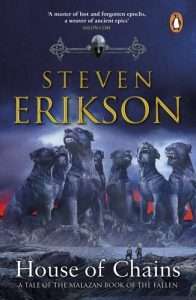 “One day, perhaps, you will see for yourself that regrets are as nothing. The value lies in how they are answered.”
“One day, perhaps, you will see for yourself that regrets are as nothing. The value lies in how they are answered.”
With Memories of Ice being the sequel to Gardens of the Moon, House of Chains is the direct sequel to Deadhouse Gates. Allegedly this odd structure happened because Erikson had a computer failure after writing the first few hundred pages of Memories of Ice, but it does create an uneven flow. The Chain of Dogs was relentlessly tragic, the battle of Coral unbelievably epic, and then were placed back in the desert, searching for purpose amidst the sand. It feels intentional, as we spend most of our time with the characters being given confusing—and seemingly futile—tasks. Erikson, as always, asks for your trust, and you simply have to read and find out to start to gain some vision into the core plot of Malazan.
Now, you may notice that I said House of Chains is the most straightforward Malazan book, and then I immediately went into talking about the confusion in the desert. While it’s true that we spend a bulk of the time in the hazy heat and parching thirsts, what makes this novel more straightforward is where we spend the first one hundred and fifty pages; one POV: Karsa Orlong.
“You have learned much, Karsa Orlong.”
“I have, T’lan Imass. As you shall witness.”
Witness is a phrase you’ll hear frequently from the Tobalaki known as Karsa. He’s a brute, straightforward and eager for blood. But he’s more than that, or at least, he becomes more than that. Karsa’s journey is arguably the most intriguing in the series. While there’s no true main character in Malazan, he is a strong contender if you had to pick one. We see his start in House of Chains, and as previously noted, we have a lengthy amount of time with him as the sole-POV, a rarity for Erikson. The result is a fascinating—if often grim—character study with themes of opening your eyes to the truth and seeing the world for how it really is.
If you’re reading this review, I’m assuming you’ve read the other three books, which means you already know Erikson’s writing style, strengths, and weaknesses. There’s no noticeable improvement in skill in House of Chains, but Erikson remains near the top of the pantheon of fantasy writers. When you combine the facets of prose, dialogue, and worldbuilding, Erikson shows dizzying skills and stands alone.
That said, I found House of Chains to be one of the weaker Malazan novels. The climax, while tragic, isn’t as deeply moving or thunderingly epic as the other books; the journey, while littered with great characters and dialogue, passes by slowly. It feels like “middle book syndrome” personified.
There’s strengths to House of Chains, and we do get a much greater sense of what the “core plot” of Erikson’s masterwork is really all about, but like I said, I found it one of the weaker novels of the ten. At the end of the day, it’s still a great piece, and if you’re reading this and found House of Chains a bit on the rough side and are considering DNFing the series, I implore you to continue. Erikson’s next slew of books stun, and House of Chains is an important step on an epic journey.
Read House of Chains by Steven EriksonThe post REVIEW: House of Chains by Steven Erikson appeared first on Grimdark Magazine.
April 25, 2025
REVIEW: Daredevil: Born Again
Daredevil: Born Again is a compelling return for the Man Without Fear as the red- costumed superhero makes the leap from Netflix to Disney+ following three critically acclaimed seasons. Blending the gritty essence of the original series with a fresh writing team, Charlie Cox returns as the masked vigilante as he fights against Vincent D’Onofrio’s Wilson Fisk who has now become New York City’s Mayor.
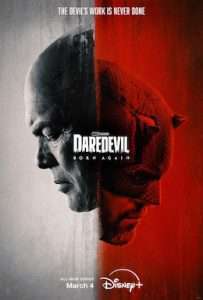 Daredevil: Born Again begins with familiarity. Matt Murdock is enjoying time with his friends including Foggy Nelson and Karen Page and all seems well. An attack from old foe Bullseye leads to tragedy and by the end of the night, the trio is broken and Matt decides to hang up the mask and fight crime the legal way. At the same time, Wilson Fisk is dealing with the fallout from the events seen in Echo. He needs to repair his relationship with wife Vanessa and prove to her that he still has the skills to run their business and do what is best for them whilst running for Mayor of New York and vowing to end the reign of masked vigilantes. It is a simple story that creates challenges for Matt as he struggles to defend his clients in the legal way when there is so much corruption in the city and especially amongst a police force that have started to obsess over The Punisher and his violent methods. He is also dealing with the pain from losing his friends and now also has to keep his eye on growing power of Fisk.
Daredevil: Born Again begins with familiarity. Matt Murdock is enjoying time with his friends including Foggy Nelson and Karen Page and all seems well. An attack from old foe Bullseye leads to tragedy and by the end of the night, the trio is broken and Matt decides to hang up the mask and fight crime the legal way. At the same time, Wilson Fisk is dealing with the fallout from the events seen in Echo. He needs to repair his relationship with wife Vanessa and prove to her that he still has the skills to run their business and do what is best for them whilst running for Mayor of New York and vowing to end the reign of masked vigilantes. It is a simple story that creates challenges for Matt as he struggles to defend his clients in the legal way when there is so much corruption in the city and especially amongst a police force that have started to obsess over The Punisher and his violent methods. He is also dealing with the pain from losing his friends and now also has to keep his eye on growing power of Fisk.
There were worries about Daredevil: Born Again being on Disney+. Fans loved the gritty, brutal nature of the series but those worries were laid to rest within the first episode. The series is just as brutal as fans remember (sometimes more so) and it really puts Matt through hell as he wrestles with his demons and comes to realise the importance of being Daredevil and defending those who are defenceless. The fight scenes are incredible (especially one where Daredevil joins up with an old friend…) and the scenes with Cox and D’Onofrio together make you crave more. It shows that the writing team and the cast truly understand the characters and fans of the comics and the original series will be dying for more. The only part of the season that fell flat for me was the forced relationship between Matt and new love interest Heather. There isn’t much chemistry between the two which is a shame following the dynamic between Matt and his previous loves. Their story feels a bit bland and forced and slows down the pacing in the middle of the season.
Overall, Daredevil: Born Again is a terrific comeback. A brutal, gritty series about corruption and the lengths people will go to protect those around them is just what the Marvel Cinematic Universe needed, and it is always great to see Daredevil back on the screen. Impactful fight scenes, genuine stakes, and great character development mean that Daredevil: Born Again is one of the best superhero series on TV. Fingers crossed we get another season!
The post REVIEW: Daredevil: Born Again appeared first on Grimdark Magazine.



